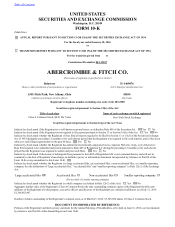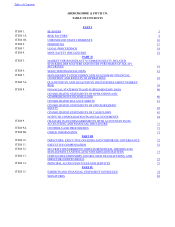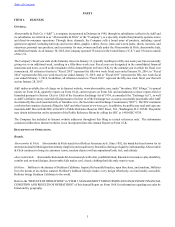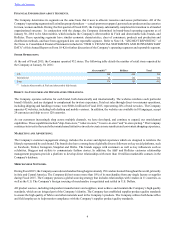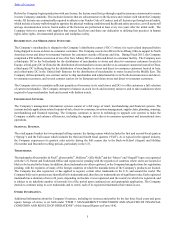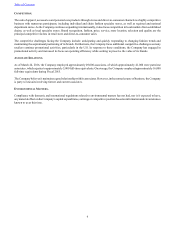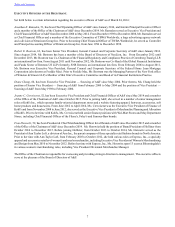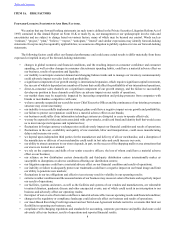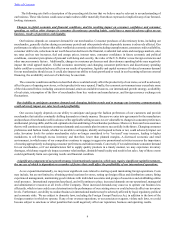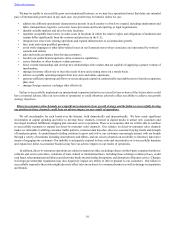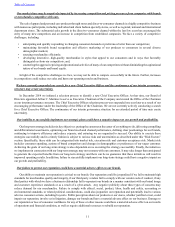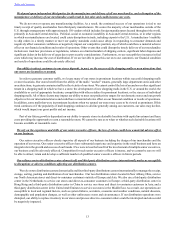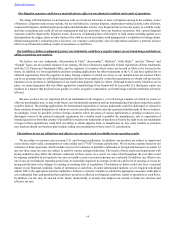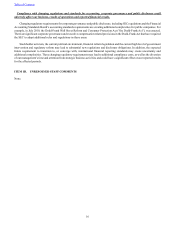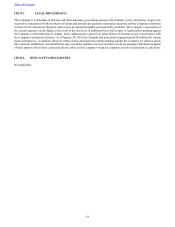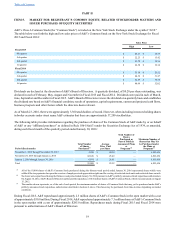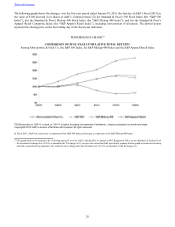Abercrombie & Fitch 2015 Annual Report Download - page 11
Download and view the complete annual report
Please find page 11 of the 2015 Abercrombie & Fitch annual report below. You can navigate through the pages in the report by either clicking on the pages listed below, or by using the keyword search tool below to find specific information within the annual report.
Table of Contents
11
Our market share may be negatively impacted by increasing competition and pricing pressures from companies with brands
or merchandise competitive with ours.
The sale of apparel and personal care products through stores and direct-to-consumer channels is a highly competitive business
with numerous participants, including individual and chain fashion specialty stores, as well as regional, national and international
department stores. The substantial sales growth in the direct-to-consumer channel within the last few years has encouraged the
entry of many new competitors and an increase in competition from established companies. We face a variety of competitive
challenges, including:
• anticipating and quickly responding to changing consumer demands or preferences better than our competitors;
• maintaining favorable brand recognition and effective marketing of our products to consumers in several diverse
demographic markets;
• sourcing merchandise efficiently;
• developing innovative, high-quality merchandise in styles that appeal to our consumers and in ways that favorably
distinguish us from our competitors; and,
• countering the aggressive pricing and promotional activities of many of our competitors without diminishing the aspirational
nature of our brands and brand equity.
In light of the competitive challenges we face, we may not be able to compete successfully in the future. Further, increases
in competition could reduce our sales and harm our operating results and business.
We have currently suspended our search for a new Chief Executive Officer and the continuance of our interim governance
structure may create uncertainty.
In December 2014 we initiated a selection process to identify a new Chief Executive Officer. At that time, our Board of
Directors appointed Arthur C. Martinez to serve as Executive Chairman of the Company and created the Office of the Chairman
as our interim governance structure. The Chief Executive Officer selection process was suspended one year later as a result of our
encouraging performance under the leadership of the Office of the Chairman. We are not currently actively conducting a search
for a Chief Executive Officer. The continuance of our interim governance structure for an extended period of time may create
uncertainty.
Our inability to successfully implement our strategic plans could have a negative impact on our growth and profitability.
Our long-term strategy includes six key objectives: putting the customer at the center of everything we do, delivering compelling
and differentiated assortments, optimizing our brand reach and channel performance, defining clear positionings for our brands,
continuing to improve efficiency and reduce expense, and ensuring we are organized to succeed. Our ability to execute these
strategies successfully and in a timely fashion is subject to various risks and uncertainties as described under this “Risk Factors”
section. Specifically, these risks can be categorized into market risk, execution risk and customer acceptance risk. Market risk
includes consumer spending, actions of brand competitors and changes in demographics or preferences of our target customer.
Achieving the goals of our long-term strategy is also dependent on us executing the strategy successfully. Finally, the initiatives
we implement in connection with our long-term strategy may not resonate with our customers. It may take longer than anticipated
to generate the expected benefits from our long-term strategy and there can be no guarantee that these initiatives will result in
improved operating results. In addition, failure to successfully implement our long-term strategy could have a negative impact on
our growth and profitability.
Our failure to protect our reputation could have a material adverse effect on our brands.
Our ability to maintain our reputation is critical to our brands. Our reputation could be jeopardized if we fail to maintain high
standards for merchandise quality and integrity, if our third-party vendors fail to comply with our vendor code of conduct, if any
third parties with which we have a business relationship fail to represent our brands in a manner consistent with our brand image
and customer experience standards or as a result of a cyber-attack. Any negative publicity about these types of concerns may
reduce demand for our merchandise. Failure to comply with ethical, social, product, labor, health and safety, accounting or
environmental standards, or related political considerations, could also jeopardize our reputation and potentially lead to various
adverse consumer actions, including boycotts. Public perception about our products or our stores, whether justified or not, could
impair our reputation, involve us in litigation, damage our brands and have a material adverse effect on our business. Damage to
our reputation or loss of consumer confidence for any of these or other reasons could have a material adverse effect on our results
of operations and financial condition, as well as require additional resources to rebuild our reputation.

